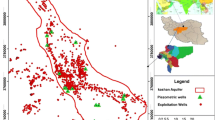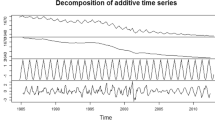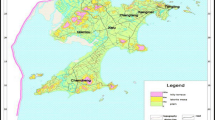Abstract
Best water management practices should involve the prediction of the availability of groundwater resources. To predict/forecast and consequently manage these water resources, two known methods are discussed: a time series method using the autoregressive integrated moving average (ARIMA) and a geostatistical method using sequential Gaussian simulation (SGS). This study was conducted in the Ecological Station of Santa Barbara (EEcSB), located at the Bauru Aquifer System domain, a substantial water source for the countryside of São Paulo State, Brazil. The relevance of this study lies in the fact that the 2013/2014 hydrological year was one of the driest periods ever recorded in São Paulo State, which was directly reflected in the groundwater table level behavior. A hydroclimatological network comprising 49 wells was set up to monitor the groundwater table depths at EEcSB to capture this response. The traditional time series has the advantage that it has been created to forecast and the disadvantage that an interpolation method must also be used to generate a spatially distributed map. On the other hand, a geostatistical approach can generate a map directly. To properly compare the results, both methods were used to predict/forecast the groundwater table levels at the next four measured times at the wells’ locations. The errors show that SGS achieves a slightly higher level of accuracy and considered anomalous events (e.g., severe drought). Meanwhile, the ARIMA models are considered better for monitoring the aquifer because they achieved the same accuracy level as SGS in the 2-month forecast and a higher precision at all periods and can be optimized automatically by using the Akaike information criterion.











Similar content being viewed by others
References
Akaike, H. (1974). A new look at the statistical model identification. IEEE Transactions on Automatic Control, 19(6), 716–723. https://doi.org/10.1109/TAC.1974.1100705.
Amaranto, A., Munoz-Arriola, F., Corzo, G., Solomatine, D. P., & Meyer, G. (2018). Semi-seasonal groundwater forecast using multiple data-driven models in an irrigated cropland. Journal of Hydroinformatics. https://doi.org/10.2166/hydro.2018.002. (in press).
Bierkens, M. F. P. (2001). Spatio-temporal modelling of the soil water balance using a stochastic model and soil profile descriptions. Geoderma, 103(1–2), 27–50. https://doi.org/10.1016/S0016-7061(01)00068-4.
Bierkens, M. F. P., Knotters, M., & Hoogland, T. (2001). Space-time modeling of water table depth using a regionalized time series model and the Kalman Filter. Water Resources Research, 37(5), 1277–1290. https://doi.org/10.1029/2000WR900353.
Box, G. E. P., & Jenkins, G. M. (1970). Time series analysis: Forecasting and control. San Francisco: Holden-day.
Box, G. E. P., Jenkins, G. M., Reinsel, G. C., & Ljung, G. M. (2016). Time series analysis: Forecasting and control (5th ed.). Hoboken: Wiley.
Brockwell, P. J., & Davis, R. A. (2010). Introduction to time series and forecasting (2nd ed.). New York: Springer.
Castrignanò, A., & Buttafuoco, G. (2004). Geostatistical stochastic simulation of soil water content in a forested area of south Italy. Biosystems Engineering, 87(2), 257–266. https://doi.org/10.1016/j.biosystemseng.2003.11.002.
CETESB. (2013). Qualidade das águas subterrâneas do estado de São Paulo 2010–2012, Companhia Ambiental do Estado de São Paulo. http://cetesb.sp.gov.br/wp-content/uploads/sites/42/2013/11/aguas_sub_2012.pdf. Accessed July 13, 2017.
Chatfield, C. (2003). The analysis of time series: An introduction. Boca Raton: CRC Press Company.
Chilès, J. P., & Delfiner, P. (1999). Geostatistics: Modeling spatial uncertainty. Hoboken: Wiley.
Chitsazan, M., Rahmani, G., & Neyamadpour, A. J. (2015). Forecasting groundwater level by artificial neural networks as an alternative approach to groundwater modeling. Journal of the Geological Society of India, 85(1), 98–106. https://doi.org/10.1007/s12594-015-0197-4.
Coelho, C. A. S., Cardoso, D. H. F., & Firpo, M. A. F. (2016). Precipitation diagnostics of an exceptionally dry event in São Paulo, Brazil. Theoretical and Applied Climatology, 125(3–4), 769–784. https://doi.org/10.1007/s00704-015-1540-9.
Cowpertwait, P. S. P., & Metcalfe, A. V. (2009). Introductory time series with R. New York: Springer.
Cressie, N., & Holan, S. H. (2011). Editorial: Special issue on time series in the environmental sciences. Journal of Time Series Analysis, 32(4), 337–338. https://doi.org/10.1111/j.1467-9892.2011.00739.x.
Cressie, N., & Wikle, C. K. (2011). Statistics for spatio-temporal data. Hoboken: Wiley.
DAEE. (2013). Águas subterrâneas no Estado de São Paulo. Diretrizes de Utilização e Proteção, Departamento de Águas e Energia Elétrica do Estado de São Paulo. http://www.daee.sp.gov.br/acervoepesquisa/Atlas%20-%20%C3%81guas%20Subterr%C3%A2neas%20(DAEE-LEBAC).pdf. Accessed July 13, 2017.
Dagan, G. (2002). An overview of stochastic modeling of groundwater flow and transport: From theory to application. EOS (Transactions American Geophysical Union), 83(53), 621–625. https://doi.org/10.1029/2002EO000421.
Daliakopoulos, I. N., Coulibaly, P., & Tsanis, I. K. (2005). Groundwater level forecasting using artificial neural networks. Journal of Hydrology, 309, 229–240. https://doi.org/10.1016/j.jhydrol.2004.12.001.
De Gruijter, J. J., Brus, D. J., Bierkens, M. F. P., & Knotters, M. (2006). Sampling for natural resource monitoring. Berlin: Springer.
Deutsch, C. V., & Journel, A. G. (1998). GSLIB: Geostatistical software library and user’s guide (2nd ed.). New York: Oxford University Press.
Dimitrakopoulos, R., & Luo, X. (1994). Spatiotemporal modeling: Covariances and ordinary kriging system. In R. Dimitrakopoulos (Ed.), Geostatistics for the next century (pp. 88–93). Dordrecht: Springer.
Djurovic, N., Domazet, M., Stricevic, R., Pocuca, V., Spalevic, V., Pivic, R., et al. (2015). Comparison of groundwater level models based on artificial neural networks and ANFIS. The Scientific World Journal. https://doi.org/10.1155/2015/742138.
Ghose, D. K., Panda, S. S., & Swain, P. C. (2010). Prediction of water table depth in western region, Orissa using BPNN and RBFN neural networks. Journal of Hydrology, 394(3–4), 296–304. https://doi.org/10.1016/j.jhydrol.2010.09.003.
Goovaerts, P. (1997). Geostatistics for national resources evaluation. New York: Oxford University Press.
Hatch, C. E., Fisher, A. T., Revenaugh, J. S., Constantz, J., & Ruehl, C. (2006). Quantifying surface water–groundwater interactions using time series analysis of streambed thermal records: Method development. Water Resources Research, 42, W10410. https://doi.org/10.1029/2005WR004787.
Hijmans, R. J. (2017). ‘raster’: Geographic data analysis and modeling. R Package (version 2.6-7). https://CRAN.R-project.org/package=raster Accessed May 13, 2018.
Hocking, M., & Kelly, B. F. J. (2016). Groundwater recharge and time lag measurement through Vertosols using impulse response functions. Journal of Hydrology, 535, 22–35. https://doi.org/10.1016/j.jhydrol.2016.01.042.
Hurvich, C. M., & Tsai, C. L. (1989). Regression and time series model selection in small samples. Biometrika, 76(2), 297–307. https://doi.org/10.1093/biomet/76.2.297.
Hyndman, R. J. (2017). ‘forecast’: Forecasting functions for time series and linear models. R package version 8.0, http://github.com/robjhyndman/forecast. Accessed July 12, 2017.
Hyndman, R. J., & Khandakar, Y. (2008). Automatic time series forecasting: The forecast package for R. Journal of Statistical Software, 27(3), 1–22. https://doi.org/10.18637/jss.v027.i03.
Janacek, G. (2001). Practical time series. London: Hodder Education Publishers.
Journel, A. G. (1989). Fundamentals of geostatistics in five lessons. Washington: American Geophysical Union.
Journel, A. G., & Huijbregts, Ch J. (1978). Mining geostatistics. San Diego: Academic Press.
Knotters, M., & Bierkens, M. F. P. (2001). Predicting water table depths in space and time using a regionalized time series model. Geoderma, 103(1–2), 51–77. https://doi.org/10.1016/S0016-7061(01)00069-6.
Kyriakidis, P. C., & Journel, A. G. (1999). Geostatistical space-time models: A review. Mathematical Geology, 31(6), 651–684. https://doi.org/10.1023/A:1007528426688.
Lantuéjoul, C. (2002). Geostatistical simulations: Models and algorithms. Berlin: Springer.
Lee, S. Y., Carle, S. F., & Fogg, G. E. (2007). Geologic heterogeneity and a comparison of two geostatistical models: Sequential Gaussian and transition probability-based geostatistical simulation. Advances in Water Resources, 30(9), 1914–1932. https://doi.org/10.1016/j.advwatres.2007.03.005.
Mackay, J. D., Jackson, C. R., Brookshaw, A., Scaife, A. A., Cook, J., & Ward, R. S. (2015). Seasonal forecasting of groundwater levels in principal aquifers of the United Kingdom. Journal of Hydrology, 530, 815–828. https://doi.org/10.1016/j.jhydrol.2015.10.018.
Manzione, R. L., Knotters, M., Heuvelink, G. B. M., Von Asmuth, J. R., & Camara, G. (2008). Predictive risk mapping of water table depths in a Brazilian Cerrado area. In A. Stein, S. Wenzhong, & W. Bijker (Eds.), Quality aspects in spatial data mining (pp. 73–89). Boca Raton: CRC.
Manzione, R. L., Soldera, B. C., & Wendland, E. C. (2017). Groundwater system response at sites with different agricultural land uses: Case of the Guarani Aquifer outcrop area, Brotas/SP-Brazil. Hydrological Sciences Journal, 62(1), 28–35. https://doi.org/10.1080/02626667.2016.1154148.
Melo, A. C. G. & Durigan, G. (2011). Plano de manejo da Estação Ecológica de Santa Bárbara, Secretaria do Meio Ambiente do Governo do Estado de São Paulo (Instituto Florestal). http://iflorestal.sp.gov.br/institutoflorestal/files/2013/03/Plano_de_Manejo_EEc_Santa_Barbara.pdf. Accessed July 13, 2017.
Mohanty, S., Jha, M. K., Raul, S. K., Panda, R. K., & Sudheer, K. P. (2015). Using artificial neural network approach for simultaneous forecasting of weekly groundwater levels at multiple sites. Water Resources Management, 29(15), 5521–5532. https://doi.org/10.1007/s11269-015-1132-6.
Montgomery, D. C., Jennings, C. L., & Kulahci, M. (2015). Introduction to time series analysis and forecasting (2nd ed.). Hoboken: Wiley.
Newbold, P., Agiakloglou, C., & Miller, J. (1993). Long-term inference based on short-term forecasting models. In T. S. Rao (Ed.), Developments in time series analysis (pp. 9–25). London: Chapman & Hall.
Nourani, V., Ejlali, R. G., & Alami, M. T. (2011). Spatiotemporal groundwater level forecasting in coastal aquifers by hybrid neural network-geostatistics model: A case study. Environmental Engineering Science, 28(3), 217–228. https://doi.org/10.1089/ees.2010.0174.
Nunes, R., & Almeida, J. A. (2010). Parallelization of sequential Gaussian, indicator and direct simulation algorithms. Computers & Geosciences, 36(8), 1042–1052. https://doi.org/10.1016/j.cageo.2010.03.005.
Olea, R. A. (1999). Geostatistics for engineers and earth scientists. New York: Springer.
Omran, E. E. (2016). A stochastic simulation model to early predict susceptible areas to water table level fluctuations in North Sinai, Egypt. The Egyptian Journal of Remote Sensing and Space Science, 19(2), 235–257. https://doi.org/10.1016/j.ejrs.2016.03.001.
Peterson, T. J., & Western, A. W. (2014). Nonlinear time-series modeling of unconfined groundwater head. Water Resources Research, 50, 8330–8355. https://doi.org/10.1002/2013WR014800.
Prado, R., & West, M. (2010). Time series: Modeling, computation, and inference. Boca Raton: CRC Press.
R Core Team. (2016). R: A language and environment for statistical computing. R Foundation for Statistical Computing, Vienna, Austria. https://www.R-project.org/. Accessed July 12, 2017.
Remy, N., Boucher, A., & Wu, J. (2011). Applied geostatistics with SGeMS—A user’s guide. Cambridge: Cambridge University Press.
Renard, P. (2007). Stochastic hydrogeology: What professionals really need? Ground Water, 45(5), 531–541. https://doi.org/10.1111/j.1745-6584.2007.00340.
Santos, T., & Bonotto, D. (2014). 222Rn, 226Ra and hydrochemistry in the Bauru Aquifer System, São José do Rio Preto (SP), Brazil. Applied Radiation and Isotopes, 86, 109–117. https://doi.org/10.1016/j.apradiso.2013.12.003.
Schwarz, G. (1978). Estimating the dimension of a model. The Annals of Statistics, 6(2), 461–464. http://www.jstor.org/stable/2958889. Accessed Juy 13, 2017.
Shumway, R. H., & Stoffer, D. S. (2011). Time series analysis and its application: With R examples (3rd ed.). New York: Springer.
Singh, C. K., & Katpatal, Y. B. (2017). A GIS-based design of groundwater level monitoring network using multicriteria analysis and geostatistical method. Water Resources Management, 31(13), 4149–4163. https://doi.org/10.1007/s11269-017-1737-z.
Sun, Y., Wendi, D., Kim, D. E., & Liong, S.-Y. (2016). Technical note: Application of artificial neural networks in groundwater table forecasting—A case study in a Singapore swamp forest. Hydrology and Earth System Sciences, 20, 1405–1412. https://doi.org/10.5194/hess-20-1405-2016.
Tsanis, I. K., Coulibaly, P., & Daliakopoulos, I. N. (2008). Improving groundwater level forecasting with a feedforward neural network and linearly regressed projected precipitation. Journal of Hydroinformatics, 10(4), 317–330. https://doi.org/10.2166/hydro.2008.006.
Varouchakis, E. A. (2016). Modeling of temporal groundwater level variations based on a Kalman filter adaptation algorithm with exogenous inputs. Journal of Hydroinformatics, 19(3), 191–206. https://doi.org/10.2166/hydro.2016.063.
Von Asmuth, J. R., Maas, K., Bakker, M., & Petersen, J. (2008). Modeling time series of ground water head fluctuation subjected to multiple stresses. Ground Water, 46(1), 30–40. https://doi.org/10.1111/j.1745-6584.2007.00382.x.
Woodward, W. A., Gray, H. L., & Elliott, A. C. (2011). Applied time series analysis. Boca Raton: CRC Press.
Wunsch, A., Liesch, T., & Broda, S. (2018). Forecasting groundwater levels using nonlinear autoregressive networks with exogenous input (NARX). Journal of Hydrology. https://doi.org/10.1016/j.jhydrol.2018.01.045. (in press).
Yi, M.-J., & Lee, K.-K. (2004). Transfer function-noise modelling of irregularly observed groundwater heads using precipitation data. Journal of Hydrology, 288, 272–287. https://doi.org/10.1016/j.jhydrol.2003.10.020.
Yihdego, Y., & Webb, J. A. (2011). Modeling of bore hydrographs to determine the impact of climate and land-use change in a temperate subhumid region of southeastern Australia. Hydrogelogy Journal, 19, 877–887. https://doi.org/10.1007/s10040-011-0726-1.
Zhang, Y. K., & Zhang, D. (2004). Forum: The state of stochastic hydrology. Stochastic Environment Research and Risk Assessment, 18(4), 265–265. https://doi.org/10.1007/s00477-004-0190-8.
Acknowledgments
The authors are grateful to FAPESP (São Paulo Research Foundation)—Process 2016/09737-4 for financial support during the realization of this study, CAPES (Coordination for the Improvement of Higher Education Personnel) for the first author’s Ph.D. scholarship, and Prof. Dr. Claudio Benedito Baptista Leite (UNIFESP—Brazil) for many discussions.
Author information
Authors and Affiliations
Corresponding author
Rights and permissions
About this article
Cite this article
Takafuji, E.H.d., Rocha, M.M. & Manzione, R.L. Groundwater Level Prediction/Forecasting and Assessment of Uncertainty Using SGS and ARIMA Models: A Case Study in the Bauru Aquifer System (Brazil). Nat Resour Res 28, 487–503 (2019). https://doi.org/10.1007/s11053-018-9403-6
Received:
Accepted:
Published:
Issue Date:
DOI: https://doi.org/10.1007/s11053-018-9403-6




